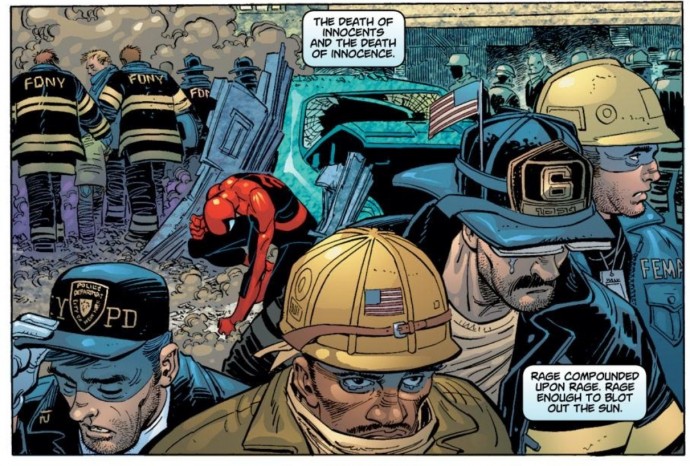 |
| Martian Manhunter, ten years before the attacks in Justice League of America |
Comics have always reflected real-life events and political climates. Many Golden Age creations were a reaction to the Second World War, whereas the pioneering comics of the Modern Age were commentary on the latter years of the Cold War. 17 years ago today, the world was met with new fears and concerns as the result of a horrific attack on the World Trade Center, which led to what could be considered a new era of comic books.
The immediate response from the comic book world to the September 11 attacks were books that directly addressed the issue and gave condolences to those affected. Marvel's Amazing Spider-Man #36, which had a plain black cover, had both heroes and villains working alongside the emergency services in the aftermath of the attack. Over at DC, Frank Miller's DK2 plans were abandoned as he used the series to comment on what had happened. Books that unintentionally paralleled the scenes of destruction, such as Adventures of Superman #596, were recalled.
 |
| Spider-Man and the emergency services in "the black issue" |
However, comics didn't stop referencing 9/11 once it stopped being in the news. Stories like The Authority pitted superheroes against terrorist organisations, and the "outsider" narrative that has been around since the debut of Superman started to become a metaphor for Muslims living in America. These themes remain prevalent over a decade later, such as Batman fighting terrorists in Batman Incorporated and the Vision's family being perceived as strange and dangerous in Tom King's Marvel miniseries.
Even manga creators in Japan were influenced by the attacks - for example, Fullmetal Alchemist provides a multifaceted look at the conflict through the allegorical region of Ishbal, and Steel Ball Run uses the setting of 1890s America to explore themes of patriotism, faith and morality.
 |
| Captain Adam builds three new towers in The Multiversity: Pax Americana |
This doesn't mean that every comic has to explicitly address these issues, but art and dialogue that evokes present-day attitudes helps to suspend your disbelief and get absorbed into the story. For example, the Rebirth line of Superman comics by Peter Tomasi delivers the theme of seeking normalcy in a postmodern world with contemporary writing and high-quality artwork.
 |
| The Man of Tomorrow looks towards a brighter future in Superman: Rebirth |
Comic books, like film and music, can provide both an escape from the troubles of the world we live in and an analysis of them. They have thrived under the shadow of the September 11 attacks, demonstrating the power of creativity as a shining light in dark times. Fear, sadness and indignation are all emotions poured into these creations - but today, above all else, it is important to focus on solicitude for everybody who was affected 17 years ago. May we never forget them.

Comments
Post a Comment